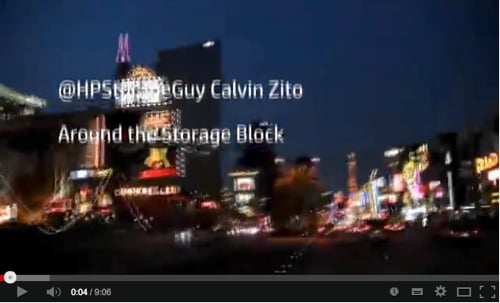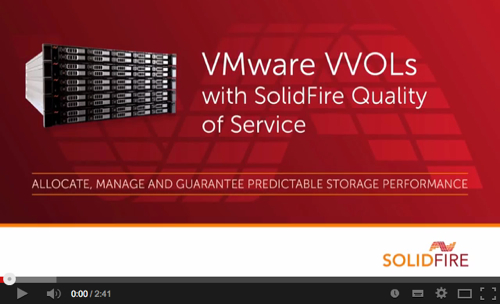Original URL: https://www.theregister.com/2014/07/22/gearing_up_for_vvols_vmware/
The triumph of VVOL: Everyone's jumping into bed with VMware
'Bandwagon'? Yes, we're on it and so what, say big dogs
Posted in Storage, 22nd July 2014 18:27 GMT
Mega-roundup A storage array access revolution is coming, says VMware as it releases its VVOL Virtual Volumes. These allow storage arrays to do a virtualised server's bidding and have storage pools and operations carried out in VMware virtual machine-centric ways.
VMware has announced its beta programme for a forthcoming release of VMware which includes VVOLs.
How are storage suppliers progressing with their VVOL support? This is a selection of what some suppliers are doing; there are too many to fit in one story and we'll add a second tranche later.
Atlantis Software
Atlantis Software has a strong VVOL support and benefits proposition. Founder and CTO Chetan Venkatesh said: “Atlantis will be demonstrating VVOL capability on Atlantis USX at VMworld 2014. Atlantis has a very disruptive value proposition for VVOL technology and believe we are the secret weapon that allows VMware to completely virtualise storage and commoditise SAN/NAS (even more than VSAN does) by allowing all storage (past, present and future) to instantly become VVOL compliant with Atlantis USX.”
“This would allow any VMware customer to manage their SAN/NAS, irrespective of manufacturer, through VVOL without needing to update/upgrade/refresh their SAN/NAS hardware. Atlantis USX brings VVOL support to 300 billion dollars of deployed storage infrastructure in production today. Every SAN/NAS model in the market automatically becomes VVOL capable with Atlantis USX,” continued Venkatesh. So how does this work?
Venkatesh again: “Atlantis USX 2.0 (GA in Aug 2014) will provide VVOL storage policy based management. USX can virtualise and pool all forms of storage - SAN/NAS or DAS and even cloud (use Amazon S3 bucket storage as near line block storage). This pool of storage can be managed completely as VVOL objects - a VMware administrator can set policy at the container or per-VM level of what specific storage capabilities they want enabled.”
“The capabilities are enabled via Atlantis USX data services. These are capabilities like - deduplication, compression, encryption, snapshot, clone, replication, long distance mirroring, n-way replication, backup and DR. The underlying storage does not need to support either VVOL or the capability - Atlantis USX provides the VVOL abstraction as well as the data services to the hypervisor and makes whatever storage is plugged into USX VVOL compliant.” “VVOL will be available as a technology preview and be GA in the same time frame as vSphere 6.”
DataCore
DataCore CEO George Teixeira said: "We are on the VVOL bandwagon.[It] breaks old VMDK and LUN mapping limits and makes it easier to add DataCore value in VMware world."
EMC
The storage kingpin says its VMAX, VNX, ScaleIO and XtremIO arrays will probably have VVOL support in the second quarter of 2015. ViPR, the multi-protocol and heterogeneous software storage resource management product, will support VVOLs as well.
HDS
HDS spokesperson Fred Oh said: “In general, we view the VVOL (aka vVol) architecture as something that will positively benefit vSphere administrators by abstracting even more storage specifics - especially at the protocol level. From Hitachi’s perspective, virtualisation at both the server and storage levels is a good thing, and in line with our unified storage and converged computing strategies.”
Oh added: “We expect policy-based storage provisioning, capacity efficient per-VM level snapshotting/cloning, and management integration value-additions implemented by HDS will make our storage solutions more compelling. Ultimately, VVOL is just another evolutionary step in abstraction to provide ease-of-use and empowerment to virtualisation admins.”
So we asked him a few questions.
The Register: Which HDS storage systems will support VVOLs?
Fred Oh: We are developing support and targeting certification of VVOL over NFS with the Hitachi NAS Platform (HNAS) 4000 series. Our Hitachi VSP G1000 will also support VVOLs over Fibre Channel. We also have future storage controllers in the works that will support VVOL when released. The Hitachi Unified Compute Platform (UCP) will leverage these developments and demonstrate tighter integration with our compute blades running vSphere.
The Register: Is there a sharable time table for this?
Fred Oh: VVol support with NFS (HNAS 4000) is targeted to be GA/certified at Day 0 of vSphere 2015 release (CQ1-2015). VVol support with FC (VSP G1000) is targeted to be GA/certified by CQ2-2015
The Register: Will it involve a storage array software update?
Fred Oh: For existing platforms, yes, there will be firmware upgrades required for this. With enterprise storage, firmware upgrades are non-disruptive and do not require downtime of our systems.
The Register: Will it involve a storage array controller hardware update?
Fred Oh: No. It will support exiting Hitachi Unified Storage with HNAS 4000 series controllers and VSP G1000 systems
The Register: How will it impact virtualised server to storage array interaction?
Fred Oh: The HDS implementation of Unified VASA providers for VVol provides the foundation for richer more granular VVol-VMDK level data services. It provides a richer interaction so that VMs receive the storage and offload services they need while efficiently allocating those services to just the VMs that need it. It will allow HDS customer’s to exploit inherent capabilities of our FC and NFS storage platform and their associated services seamlessly; and match the needs of VM to appropriate storage services at greater levels of data centre efficiency.
For example, it will allow tasks like deploying VMs and VM snapshot management to be offloaded to the storage controller for greater operational efficiency - such as 100 Million VM snapshot support with NFS platform, or the ability to allow individual VM and associated VVols to be placed into a global active device (distributed topology) configuration for highest availability.
HP
Hewlett-Packard is an enthusiastic VVOL effort participant. It engaged from day 1 in the VVOL beta testing programme with the 3PAR StoreServe array.
Blogging, tweeting and mailing spokesperson Calvin Zito said, via various media: "We will support VVOLs on day 1. We've been working with VMware from the ground floor on this one. ... I have a demo I did too (video on YouTube.) It has more views than [EMC's] Chad [Sakac]'s demo. LOL!"

Click to jump to the vid. It's blurry, by the way, because it's a fast video captured with a slow screen grabber
This video was put up on YouTube in October 2012; that's early.
PS: We understand IBM ran a flawless VVOL support demonstration with its XIV array at VMworld 2013.
NetApp, Pure, Tintri and Solidfire
NetApp
NetApp was a very early VVOL bird indeed.
Senior solutions manager Graham Smith provided some info via email about the original inception of the VVOL idea: "It started as an initiative between NetApp and VMware to extend VAAI storage offloads and had started before I joined NetApp 4 years ago. EMC and Dell were also early partners. I believe the idea was first presented at VMware 2011."
He talked about the current activity: "We are supporting the VVol beta that went public last month with a shipping version of Clustered Data ONTAP (8.2.1), along with a beta version of our VASA provider and our vCenter plug-in VSC (Virtual Storage Console), to provide the user interface. Customers can also download the Clustered Data ONTAP simulators (a VM) from our website and set up a virtual environment to try VVols."
"Our support of VVol covers SAN (FC and iSCSI) as well as NFS. NetApp is also a key design partner. If you sign up to the VMware beta for vSphere, you will see NetApp is 1 of 3 vendors (as of today), and the only vendor that allows open access as the other 2 vendors seem to be restricting the release of their beta code."
We probed him a little further:
The Register: Why is NetApp participating in the VVOL effort?
Graham Smith: Simply put, it helps our joint VMware/NetApp customers leverage ONTAP's abilities such as per Virtual Disk cloning, Snapshots, QoS setting and mobility into a usable VM granular management framework (vCenter).
Pure Storage
Pure Storage is another keen VVOL developer.
The Register: Which Pure Storage systems will support VVOLs?
Pure: All FA-400 series arrays, as well as future platforms.
The Register: Is there a sharable time table for this?
Pure: We will deliver support for VVOLs following VMware's GA release, which is expected in 2015.
The Register: Will it involve a storage array software update?
Pure: Yes, an updated version of the Purity Operating Environment will be required. All customers with active support contracts will be able to non-disruptively upgrade their FlashArrays to support VVOLs, at no cost and with no disruption to IO operations and performance.
The Register: Will it involve a storage array controller hardware update?
Pure: No hardware upgrade is required, provided the customer is on a supported array.
The Register: How will it impact virtualised server to storage array interaction?
Pure: VVOLs will provide a level of need to end management and operations that has previously been unavailable with virtual infrastructures. We should expect to see greater capabilities in areas of performance, quality of service, simplification of backups and reduced RTOs, and end-to-end reporting and monitoring.
Solidfire
Solidfire has VVOL support planned and was, we understand, one of VMware's early tech partners in VVOL development. It has a video up on YouTube that demonstrates its Quality of Service facilities working with VVOL.
PS: Hybrid array startup Tegile has VVOL support planned.
Tintri
Tintri has been the pioneer in producing VM-aware storage arrays.
A Tintri spokesperson said: "Tintri and VMware share the same view that the traditional storage model doesn't work for virtualised environments. Tintri has been a VVOLs design partner and we are working with VMware on VVOLs. We demonstrated our VVOLs implementation at VMworld last year and will be doing so again at this year’s VMworld."
"While it was very straightforward for Tintri to implement VVOLs on our VM-level architecture, it will be far more difficult to provide a good implementation on a storage system designed to support LUNs or volumes. For those customers who want to use VMware’s VVOLs, Tintri will have the best implementation in the market that leverages our FlashFirst architecture to provide 99 per cent of all IO from flash for consistent sub-millisecond latencies."
"Also, unlike other vendors’ implementations, customers using Tintri VMstore systems will be able to leverage per-VM replication using Tintri ReplicateVM and built-in per-VM QoS mechanisms."
We'll add information about additional VVOL-supporting storage vendors in a subsequent story. We think it will be a rare storage supplier that does not support them.
OK, you got me; maybe StorSimple might. ®
